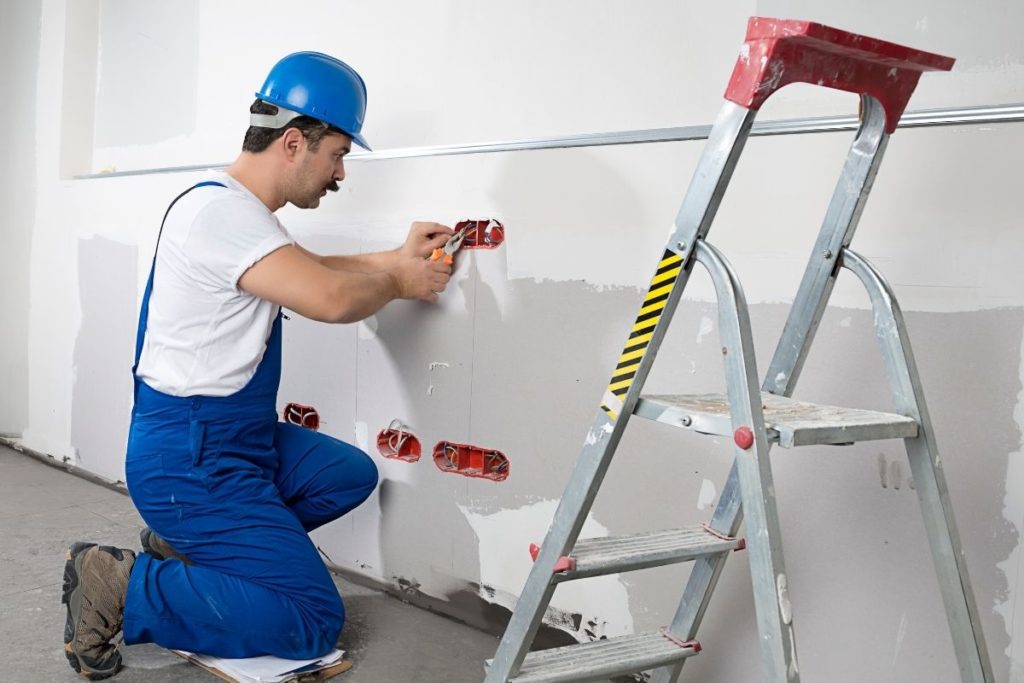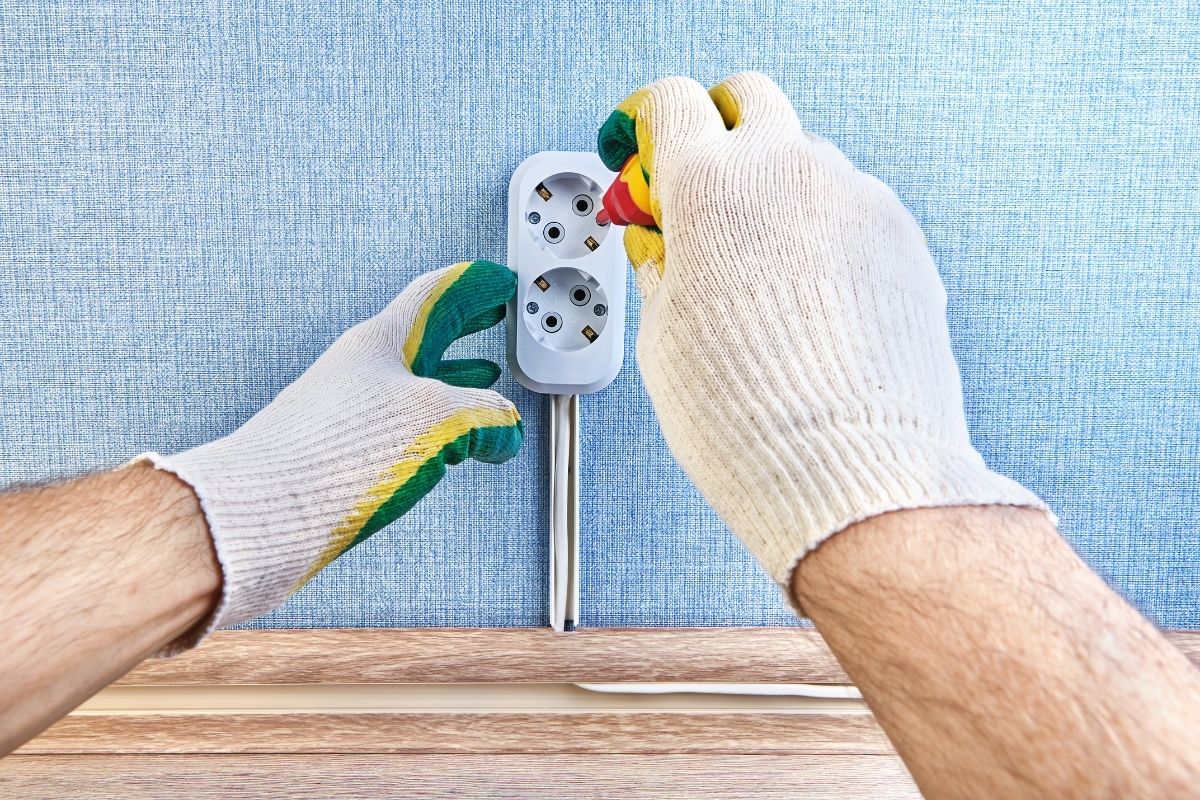Mr. Electric has a list of instructions showing his readers how they can install an outlet. But the very first step is to turn the power off. It isn’t enough to flip the switch on the outlet to the ‘OFF’ position. It would be best if you also tripped the breaker. But what if you can’t switch the power off?
Can You Change An Electrical Outlet Without Shutting Off The Power?
Professional electricians can install outlets on live circuits because they know what they’re doing. A layperson shouldn’t attempt this procedure. If you’ve started installing an outlet on a live circuit, but you’re no longer confident in your ability to safely connect or disconnect the live wire, don’t hesitate to switch the power off.
Many people will encourage you to wear rubber gloves. But some people hate gloves because they are cumbersome. Installing an outlet on a live circuit is a slow process because you have to proceed carefully. Gloves will make that process even slower.
How Do You Change Wall Outlet Without Turning Off Power?

1). Start by unscrewing the cover plate.
2). Pull the outlet out of the hole and identify the hot wire. This is the wire that carries the current. You can locate it using a tester. Modern testers are very easy to use. When you place one on a hot wire, it will make a sound.
The hot wire is dangerous because it can electrocute you. Of all the conductors, the hot wire is the one to watch.
3). Once you identify the hot wire, you can start disconnecting the wires from the outlet. Do this very carefully, especially where the hot wire is concerned. Don’t touch it with your bare hands.
4). Because the circuit is still live, you should use pliers to handle the wires. Grab them and pull them out of the screws in the outlet. Pliers have rubber handles. You can use them to touch the hot without electrocuting yourself.
5). Once the wires are free, test them again to confirm that you correctly identified the hot wire. Don’t allow the hot wire to touch a grounded source.
6). At this point, the safest thing to do is to place a cap on the hot wire. Once the cap is in place, you don’t have to work carefully. You are still encouraged to apply caution. But the cap makes the hot wire a lot less dangerous. You can use your hands to handle the other wires.
7). Disconnect the old outlet completely. Get the second outlet. Connect all the other wires first. Leave the cap on the hot wire until all the other wires are connected.
8). Remove the cap and connect the hot wire. It should come last. You can use the pliers to connect it to the screw, but the procedure is difficult. You can try using your hands. You can handle the hot wire without getting electrocuted if you touch the jacketed area. Again, apply caution. Slowly push the exposed end into the screw before using the screwdriver to secure it. You need a firm, stable hand to do this without incident.
9). Once the hot wire is connected, the hard part is over. You can push the outlet back into the hole. Apply the screws and test the outlet to ensure that it was wired properly.
For detailed information, you can watch the below video that shows you how to handle the hot wire without getting shocked. Don’t install outlets on a live circuit if you don’t have experience with electrical installations.
Do You Need To Cut The Power To Change An Outlet?
You need to cut the power to change an outlet. Every professional electrician starts an electrical installation by cutting the power.
If you’re thinking about adding or changing an outlet without de-energizing the circuit, keep the following in mind:
1). You Can Get Electrical Shock
Many people in places like the US change outlets without switching the power off because the US uses 120V, whereas countries like the UK have 240V. Some individuals in the US argue that 120V is safer. You can afford to receive a shock from a 120V power supply because it won’t kill you.
However, that isn’t true. Yes, a shock from a 120V power supply is less likely to kill you than a shock from a 240V power supply. But that doesn’t make 120V power supplies safe.
At the end of the day, it comes down to the path the current will take. If it cuts across your heart, it could kill you. The fact that your home has 120V rather than 240V doesn’t make the circuit harmless.
2). Try To Have Dry Skin
If you have to work on a live circuit, have you taken the necessary precautions? Better yet, are you dry?
According to the New York Committee For Occupational Safety and Health, dry skin has more resistance. Once your skin is wet, the resistance will drop.
If you touch a hot wire, the amount of current flowing through you will spike. You are more likely to suffer lasting harm. People that are standing in water while touching a live wire can expect to suffer the same fate.
3). You Will Need Permit
If you want to change an outlet on a live wire in a commercial setting, you need a permit. This isn’t always the case. Different regions have different laws governing the installation of electrical components.
According to EHS Insight, your employer should create and distribute a list of procedures guiding electricians that have to work on live circuits. Those procedures should encourage contractors to de-energize a circuit before work commences.
If the contractors must work on the circuit without shutting the power off, the procedures should explain the precautions the contractor must take to prevent unnecessary injuries.
If you’ve decided to cut the power before changing the outlet in a commercial setting, the procedures will include protocols for verifying that the circuit has been de-energized.
You must be qualified to work on an energized circuit in such a setting. As you can see, commercial situations are quite strict where live circuits are concerned.
Naturally, this doesn’t apply to homeowners. You don’t have to apply for a permit to work on the live circuit in your home. You can change as many outlets as you want without switching the power off.
Can You Wire An Outlet With The Power On?
You can wire an outlet with the power on. But you must proceed carefully. Your biggest enemy is the hot wire. If you touch it, the current could kill you. But if you can handle the hot wire without touching the end, you can wire the outlet without dying.
Is It Safe To Replace An outlet Without Shutting Off Power?
It isn’t safe. Don’t believe anyone who tells you that 120V cannot kill you. If the current cuts across your heart, you could die. This threat explains why every contractor you consult will tell you to cut the power beforehand.
It isn’t even that difficult. Just flip the breaker switch. Once you trip the breaker, you can touch the hot wire without dying. If you don’t want to switch the power off, use pliers to handle the hot wire.
Where possible, make sure you cap it. Once you attach the cap, you can work around the hot wire with less care. But at some point, you must remove it to put the hot wire back in its place. You can try using the pliers. But it is much easier to touch the wire directly. Don’t touch the end. Keep your fingers on the insulated sections.
Conclusion
You can change an outlet without turning the power off. But this practice is dangerous. It is not encouraged. Though, at the end of the day, no one can stop you from installing an outlet on a live circuit.

